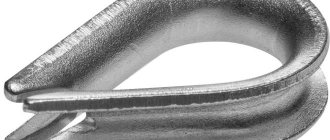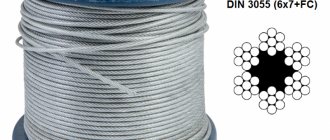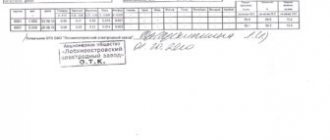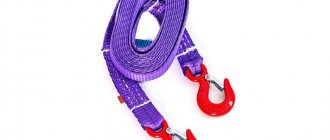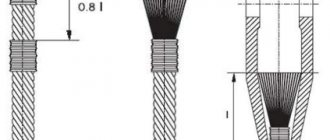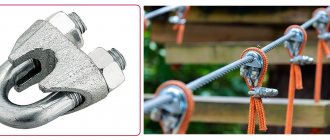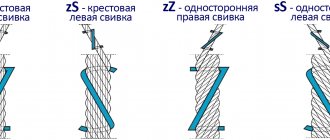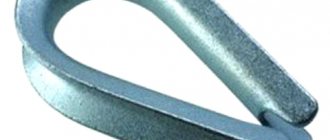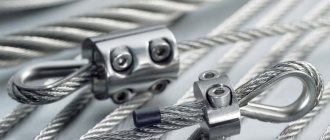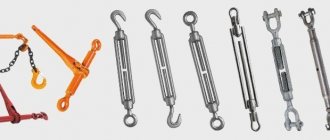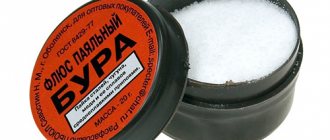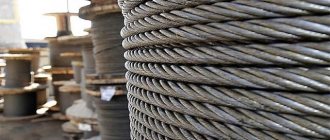Cable and rope play the role of a very strong and durable rope that can be used for various purposes, most often in construction. The ability of these materials to withstand very heavy loads makes it possible to widely use them in various fields.
A wide selection is provided by the company TechService, whose steel products are particularly successful and popular. The products of this company are distinguished by their durability and excellent functional characteristics.
Manufacturing materials
Cables are made from plant fibers, synthetic threads, and stainless steel. Each material has its own characteristics and characteristics.
Vegetable
Made from plant fibers. They are characterized by increased flexibility and softness. Among the most popular products are cables:
- Manila. They are distinguished by their mottled surface, elasticity, and strength. In cross section they reach 350 mm in diameter.
- Sisal . They have a light yellow or brownish tint, quickly absorb moisture, and are characterized by increased flexibility, lightness, and accessibility to consumers. Used in the fleet, room decoration, and for lifting operations.
- Coconut. They are not distinguished by their strength, but are valued due to their lightness and ability to float on water. They stretch when loaded.
- Hemp. They quickly absorb moisture, which is why they are susceptible to rotting. They are distinguished by softness and elasticity. Recyclable. They are used in construction, in the navy, when drilling wells, and in agriculture.
- Cotton. They are valued for their softness, elasticity, and ease of etching. Under mechanical stress they stretch greatly, and under constant exposure to moisture they quickly become moldy.
- Jute. They are distinguished by their strength, resistance to abrasion, precipitation and solar radiation. Made from environmentally friendly and safe raw materials, they do not accumulate static electricity. They are actively used for transporting heavy loads.
If a person needs a very thin cable, he can pay attention to linen products. They are not durable, but quite soft and elastic.
Synthetic
Nylon
is several times stronger than some vegetable ropes. At the same time, they are much cheaper and can withstand high temperatures:
- Nylon . They are considered high-strength, lightweight, moisture-resistant, and elastic. They have a melting point of 200°C (depending on the brand of nylon). Nylon rope can stretch up to 30%, and after the load is removed, return to its original state.
- Polyester. Wear-resistant devices often used in sailing sports. They are inferior in elasticity to nylon.
- Polyethylene. They are distinguished by durability and strength. Melts at a temperature of 180°C.
- Polypropene. Multi-strand products with high strength and flexibility. They wear out quickly, but are widely used due to their low cost.
Polyester
Polyethylene
Polypropylene
Another type of synthetic cables is Kevlar. Valued for its lightness, flexibility, and resistance to tension. Disadvantages include exposure to moisture and sun.
Steel
The diameter of such cables directly depends on the purpose.
The product consists of a steel rod wound in a spiral, surrounded by several twisted strands. The flexibility of a steel cable depends on the amount of wire in the strand. The benefits include:
- resistance to dynamic loads;
- ease of visual detection of wear defects;
- ease of operation.
The disadvantage is the inability to use in wet and aggressive environments. You can be seriously injured by protruding broken wires, and if the cable breaks during heavy loads, it can not only injure, but also kill a person. Another disadvantage is the susceptibility to rust and high weight compared to synthetic ropes.
Rope
Rope evokes different associations for different people. The rope, like the wheel, is an invaluable invention of man. However, not even of man, but of nature. In nature, rope is found at every step and it would be difficult to imagine the world around us if rope were not present in it.
The first rope that helped the monkey get down to the ground was a liana. The primeval forest was literally entangled with these natural ropes, and they were the main means of transportation of the first primates. Thanks to this rope, the hand of the great ape was largely formed. capable of grasping and firmly holding oblong objects. This means that it was the rope that became the first link that led to the transformation of a simple monkey into an ape. Read more.
Types of cables
There are several types of cables, differing in type of work, winding, and number of strands. In classical winding, the fibers are twisted three times. First they make yarn, then strands, and then twist the strands into a cable. Such cables have steep and gentle winding. In the first case, the products are not subject to rapid wear, and in the second, they are able to withstand maximum mechanical loads.
Cable works
Depending on the direction of winding, cables can be either direct (right winding) or reverse (left winding). When making products with right-hand winding, the strands are twisted in a clockwise direction, in a spiral, which is similar to a screw with a right-hand thread.
Cable works
They differ in the weave of fibers four times. They are considered denser and more wear-resistant. They are more expensive than cable ropes, but have less strength.
Square
Such products are made from eight strands, which alternate in pairs. One pair goes along the right winding, and the other goes along the left. The result is a product without twisting, quite soft, resistant to moisture penetration.
Remote control
Made from a steel core coated with lubricant. It is placed in a coil/case with a polyurethane braid. At the end of the cable, a tip is attached that fixes the position of this casing, but does not interfere with the movement of the core inside the casing.
When choosing a cable, it is necessary to take into account the field of activity in which it is planned to be used, technical and mechanical parameters. If a rope is needed for loading mechanisms, be sure to study the technical documentation, which clearly indicates the length, thickness, quality, and GOST code.
Application area
Used in a variety of areas. The main direction is production. Galvanized metal cable is used on winches and cranes, in the manufacture of overhead roads and on drilling units, excavators and lifts. They are needed for guying masts on ships, fishing structures and trolleybuses.
A safety rope will ensure safety when performing high-altitude work in industry, and it will also become insurance against falls in mountaineering.
Synthetic products are actively used in the installation of urban structures, for example, traffic lights, advertising or warning signs. Plant products are used in the manufacture of mooring lines and tugs, slings and lashings, and for other purposes.
Properly manufactured cables can solve many different problems, which has influenced their distribution.
Criterias of choice
There are a large number of parameters by which one or another type of rope is selected:
- the purpose of the product is the main criterion that determines the scope of operation, the type of loads for which it is designed, operating conditions (aggressive, non-aggressive environments, etc.);
- type of lay - the flexibility of the rope, its resistance to alternating loads, abrasive wear, etc. depend on it;
- strength - directly determines the level of loads on this equipment and its service life, as well as options for use in lifting equipment (for example, only in freight or in people lifts);
- core material – the strength of the entire structure, its reliability and durability depend on it.
Another criterion is the characteristics of the wire. For maximum long-term use, cables made of corrosion-resistant rope wire - stainless or galvanized - are recommended.
First, it’s worth understanding the terminology:
- Climbing rope is a special rope with special dynamic and strength properties, used in mountaineering, rock climbing and speleology.
- Twine (string) is a thin, strong thread for packaging, stitching, etc., made by twisting paper, bast fibers, chemical fibers or threads, as well as their combinations.
- Cord (German: Schnur) is a fairly thin cord, wire or rope.
- A tench is a thin ship's cable. In the days of the sailing fleet, it was made from hemp.
- Rope is a thick, strong rope made of intertwined plant, synthetic or metal fibers.
- Cable is a twisted or twisted rope product.
- A halyard is a tackle designed for raising and lowering sails (mainsail, staysail and others), individual parts of the spar (for example, yards, topmasts, gaffs), flags, pennants, etc. The halyards used on ships and vessels are classified as running rigging.
It turns out that these are the names of ropes and cords for various fields of activity and application, practically indistinguishable functionally. That is, a climbing rope, for example, is quite suitable as a rope for tying luggage, or for hanging laundry.
The materials from which ropes are made are divided into 2 main classes: vegetable and synthetic.
Convectors - an alternative or main source of heat
Convectors are firmly established in our daily lives. Convector,
one of the types of heating devices for central heating systems, in which most of the heat is transferred from the coolant to the heated room by convection. This is traditionally considered. However, now convectors are devices that have nothing to do with convection, although they perform heating functions.
Particular attention should be paid to electric convectors. Modern technologies make it possible, with economical energy consumption, to obtain a sufficient amount of heat to heat fairly large rooms, which can sometimes make an electric convector a quite decent alternative to the main source of heating. Read more.
